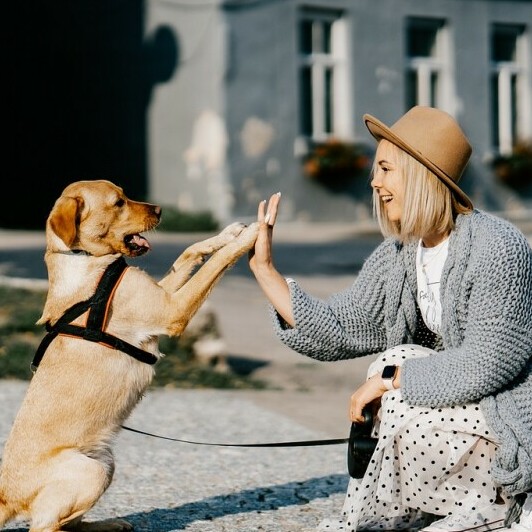Allow me (Bob) to welcome you back. Today I’m going to level with you about something that’s rather close to my heart. Training an older dog isn’t like working with a young pup full of boundless energy. But here’s the thing: it’s a journey well worth taking. My own experience with my 13-year-old ‘Puppy’ has shown me that, while there are unique hurdles to overcome, the bond that forms during training is incredibly special.
That’s going to include dealing with some of the common challenges faced when training an older dog. First up, you’ve got established behaviors—these are the habits that have been part of your dog’s routine for years, and changing them is not a small feat. There’s also the reality of potential health issues. Just like us, older dogs might contend with conditions like arthritis or vision loss, which can impact their training.
You’re going to find out about cognitive changes, too. As dogs age, just like humans, they may experience a decline in their cognitive functions, making it tougher for them to pick up new commands or routines. And let’s not forget about past experiences or traumas that could have left a mark on your dog’s behavior.
So my question to you today is, what do we do in the face of these challenges? Well, the key lies in patience, understanding, and a dash of creativity. Before we get into this, remember this isn’t just about teaching an old dog new tricks—it’s also about creating an environment where they feel safe and loved enough to try.
The Virtue of Patience: Guiding Your Aging Dog with Gentle Consistency
Patience is not just a virtue; it’s the key to successfully training your older dog. Mature dogs, like my 13-year-old furry friend, often need extra time to process new commands and alter established behaviors. Unlike puppies, whose plastic brains soak up new experiences like sponges, senior dogs may approach learning with caution and require gentle, patient guidance.
I’m going to show you how important consistency is in communicating with your older pet. Regular training sessions held at the same time each day help your dog understand what’s expected. This kind of reliability can be a comfort to older dogs, who thrive on routine. It lets them know what to expect and when, which decreases stress and confusion.
But, remember, your approach must be as flexible as it is consistent. If you notice your dog becoming fatigued or frustrated, don’t hesitate to shorten sessions or split them into smaller, more manageable chunks. You can always adjust your approach down the road to better match your dog’s endurance levels and attention span, which might fluctuate as they age.
And what about those moments when progress seems as slow as molasses? That’s when you cue up those small victory dances. Embracing even the tiniest signs of progress reinforces your commitment to your dog’s growth and well-being. Trust that, over time and with repeated effort, your older dog can learn new tricks and adopt desirable behaviors.

Tailoring Training with Tenderness: Adapting to Your Dog’s Changing Needs
If you want to effectively train an older dog, the key lies in customizing your approach. Older dogs, like my “Puppy” who’s gracefully stepped into her 13th year, respond well to kindness and understanding. You’re going to find out about using positive reinforcement, because let me tell you, it’s a game-changer. Treats, praise, and quality time do wonders for an older dog’s motivation and self-esteem.
Now, physical limitations might be part of the package when training an older dog. Don’t worry too much about this; it’s all about adaptation. For instance, if your dog has arthritis or is a bit slower on their feet, you can always adjust your approach down the road. Opt for low-impact activities, like modified fetch or slow walks that allow for training without the strain.
As for the training sessions themselves, choose something that resonates with your dog. With Puppy going outdoors is like the best thing in the world. I have always associated that with using a hand signal, knowing the day would come that her hearing most likely will fade. Or, maybe they’ve always had a thing for a certain type of treat or a soft spot for a gentle pat. Use what works and build from there. Keep in mind, it’s not about the speed of learning but rather the quality of the time you spend together.
Remember to celebrate the individuality of your furry friend. They might have quirks that require a unique touch – maybe an extra soft voice or a particular hand signal works best for them. Assess and adapt; that’s your mantra. Patience and a gentle approach often lead to surprising breakthroughs and an even stronger bond between you and your dog.
Beyond Sit and Stay: Addressing Senior Dog Behavioral Challenges
When we think about dog training, ‘sit’, ‘stay’, and ‘come here’ often dominate the conversation. But for senior dogs like my own 13-year-old ‘Puppy’, the training spectrum broadens to include addressing behavioral issues that may arise with age. You might be seeing some unwanted behaviors that seem new or have intensified over time. Don’t worry too much about this being a unique problem; it’s quite common in senior dogs.
For example, leash pulling could become an issue if your dog never quite got the hang of walking calmly, or due to nervousness that’s grown over the years. Excessive barking or even separation anxiety could manifest when they never seemed to bother your pup before. It’s crucial to understand that these aren’t acts of disobedience, but perhaps signs of underlying issues such as increased anxiety or discomfort.
You’re going to find out about positive, force-free methods to help manage these behaviors. Positive reinforcement isn’t just about teaching tricks; it’s also about behavior modification. Reward the behavior you want to see, and manage the environment to prevent the behavior you don’t. If your dog pulls on the leash, consider a front-hook harness to discourage pulling, and remember to reward moments of calm walking.
In my opinion, and many professional trainers would agree, when addressing these senior dog behaviors, seeking professional guidance can be incredibly beneficial. A certified dog trainer or a behaviorist can provide you with tailored strategies that accommodate your dog’s health and comfort level. They offer a fresh perspective, possibly identifying subtle cues that you might overlook.
Let’s not forget that training sessions are more than learning commands; they’re about continuing to build that strong relationship with your pet. Your older dog craves your attention and approval just as much as a younger one. Each training session is an opportunity to reinforce that bond, setting you up seamlessly for our next section on celebrating the progress you and your senior companion make together.

Celebrating Each Step: Acknowledging Progress and Building Lasting Bonds
When you’re training an older dog like my own 13-year-old ‘Puppy,’ you quickly realize that every small step is a milestone worth celebrating. Slow progress is still progress, and it’s important to remind yourself of that. You’re not going to see overnight transformations, and that’s perfectly okay. Instead of aiming for perfection, aim for gradual improvement and consistency.
Every time your senior companion responds to a command or shows any positive change in behavior, it’s a victory. This isn’t just about the treats or the affirmations you give. It’s about reinforcing that deep, emotional connection—that undeniable bond that has been maturing just like your furry friend. That bond gets stronger with every training session because you are communicating, understanding, and growing together.
Maintaining a routine isn’t just for the sake of training; it’s for providing a framework that supports your dog’s entire lifestyle. Consistency in feeding schedules, potty breaks, walks, and playtime provides a comforting structure, offering a sense of security to your older dog and setting the stage for successful learning and adaptation.
If you take one thing away from your journey in training an older dog, let it be the profound satisfaction that comes from advancing together in this stage of life. You’re not just teaching an old dog new tricks; you’re giving them—and yourself—the gift of quality time, patience, and mutual respect.
I really hope that you embrace the special opportunity that comes with training an older dog. Though faced with some challenges, the solutions lie within the joy of learning and growing old together. And remember, while the pace may be different, the end goal remains the same: enjoying every precious moment with your devoted companion.
